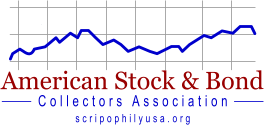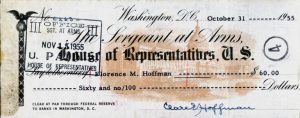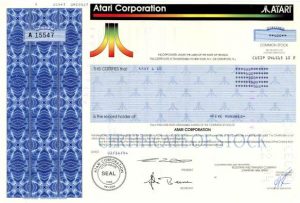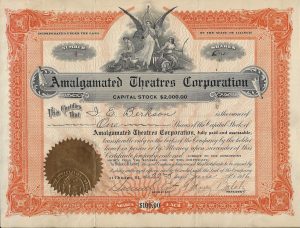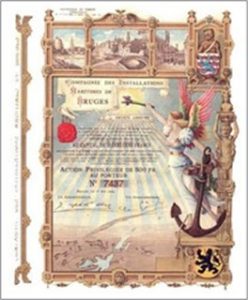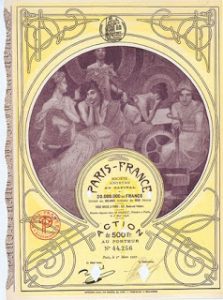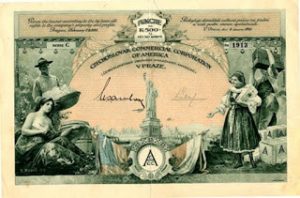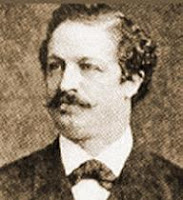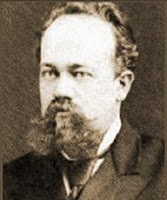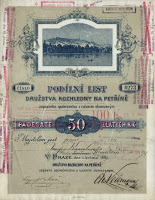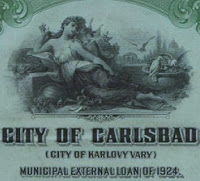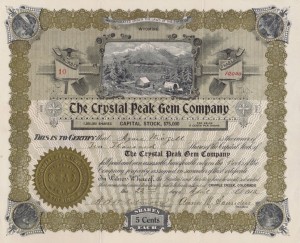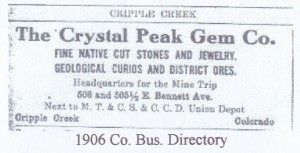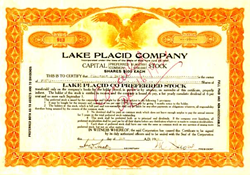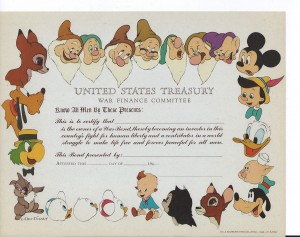
Image of Jacob Little 
Signature of Jacob Little on Certificate
Jacob Little was the first Great Bear of Wall Street. Bears on Wall Street had operated more in the United States than in Europe. Although there was a ban on short sales by the New York Legislature in 1812, the bear operator was a familiar figure in the nineteenth century. One who gained celebrity status was Jacob Little. He was a leading bear operator in the first half of the 19th century. His nick names included the “Great Bear,” the “Old Bear,” and the “Napoleon of Wall Street”. Little is also known for the Inventor of the Short Sale in the United States and the Inventor the convertible bond.
The Civil War wiped out his fortune and he died penniless.
From the book “FIFTY YEARS IN WALL STREET” by Henry Clews
MY DEBUT IN WALL STREET
MY advent in Wall Street was on the heels of the panic of 1857. That panic was known as the “Western blizzard.” It was entitled to the name, as its destructive power and chilling effects had surpassed all other financial gales that had swept over Wall Street. The first serious result of its fatal force was the failure of the Ohio Life and Trust Company, a concern of gigantic dimensions in those days.
The Company had an office in Wall Street, and on the announcement of the collapse, business became completely paralyzed. This failure was immediately followed by the suspension of many large firms that had withstood the shock of all ordinary collisions and had successfully weathered many financial storms.
The panic was due in part to excessive importations of foreign goods, and also to the rapid construction of railroads, to a large extent on borrowed capital. There were other contributing causes. The crops were bad that year, and the country was unable to pay for its imports in produce, and coin was brought to the exporting point. In October, the New York City banks suspended payments, and their example was followed throughout the country. Bank credits had been unduly expanded everywhere, and the time had naturally arrived for contraction. It came with a bound, and financial disaster spread like a whirlwind, becoming general.
The Stock Exchange had been a moderately growing concern for the ten years previous to this calamity, and the securities there dealt in had been rapidly accumulating in number and appreciating in value. Its members were wealthy and conservative, with a strong infusion of Knickerbocker blood, an admixture of the Southern element and a sprinkling of Englishmen and other foreigners.
The effect of the crisis on the majority of Stock Exchange properties was ruinous. Prices fell fifty per cent. in a few days, and a large proportion of the Board of Brokers were obliged to go into involuntary liquidation. There was a great shaking up all around.
Then came the work of rehabilitation and reorganization. Confidence gradually returned. The Young Republic had great recuperative powers, and they were thoroughly exerted in the work of resuming business. Much of the old conservative element had fallen in the general upheaval, to rise no more. This element was eliminated, and its place supplied by better material, and with young blood, and in December the banks resumed business.
This panic and its immediate results created an entire revolution in the methods of doing business in Wall Street. Prior to this time, the antique element had ruled in things financial, speculative and commercial. This crisis sounded the death knell of old fogyism in the “street.” A younger race of financiers arose and filled the places of the old conservative leaders. The change was a fine exemplification of the survival of the fittest, and proved that there was a law of natural selection in financial affairs that superseded old conservatism and sealed its doom.
Until that time, the general idea prevailed that those engaged in financial matters must be people well advanced in years, even to the verge of infirmity. It is the same idea that has been handed down, as if by divine right, from old world prejudices, especially in the learned professions. No doctor was considered a safe prescriber unless his hoary locks, bald head and wrinkled brow proclaimed that he had almost passed the period of exercising human sympathy. The same rule of judgment was applied to the lawyer and the clergyman. These unworthy prejudices were fostered by the character of the Government of the old country, and nurtured by the surroundings of the venerable monarchies of Europe, where they exist largely even to the present day. So tenacious of life are these old-fashioned ideas, that many of them were found in full vigor, dominating Wall Street affairs up to the crash of 1857, fostering the antique element and choking off salutary enterprise.
Hence the process of decay of these archaic notions and our gradual development. This struggle for new life in Wall Street was not successfully developed without a serious effort to attain it. The old potentates of the street fought hard to prolong their obstructive power, and their tenacious vitality was hard to smother, reminding one of the nine lives attributed to the feline species. The efforts of the young and enterprising men to gain an entrance to the Stock Exchange were regarded by the older members as an impertinent intrusion on the natural rights of the senior members. It was next to impossible for a young man, without powerful and wealthy patrons, to obtain membership in the New York Stock Exchange at the time of which I speak.
The old fellows were united together in a mutual admiration league, and fought the young men tooth and nail, contesting every inch of ground when a young man sought entrance to their sacred circle.
The idea then struck me that there was a chance for young men to come to the front in Wall Street. I was then engaged in the dry goods importing trade, in which I received my early training. I had been kept out of the Exchange for several years by the methods to which I have alluded. My fate was similar to that of many others. It was only by an enterprising effort, and by changing the base of my operations, that I finally succeeded.
The commissions charged at that time were an eighth of one per cent. for buying and selling, respectively. After numerous efforts to gain admission to the Exchange, without success, I finally made up my mind to force it. I at once inserted an advertisement in the newspapers, and proposed to buy and sell stocks at a sixteenth of one per cent each way. This was such a bombshell in the camp of these old fogies that they were almost paralyzed. What rendered it more distasteful to them still was the fact that, while they lost customers, I steadily gained them. The result was that they felt compelled to admit me to their ranks, so that I could be kept amenable to their rules and do business only in their own conventional fashion.
My membership cost me, in all, initiation fee and other trifling expenses in connection therewith, $500. This presents a striking contrast to the recent price of a seat, $35,000, but though this difference seems very large, yet the changes in every other respect connected with Wall Street affairs have been in similar proportion. Among some of the old members of that day were Jacob Little, John Ward, David Clarkson and others whose names may be found in the archives of the Stock Exchange. As an instance of the way in which membership was then appreciated, it may be mentioned that speculators frequently offered $100 a week, or ten times the cost of membership, for the privilege of listening at the keyhole during the calls.
Although the prostration growing out of this panic was very great and of long continuance throughout the country, general confidence being shaken to its very foundation, yet, on the whole, it was a great gain, and marked an era of financial and speculative progress. It was the chief cause in drawing out the young element in the business of Wall Street, which might have lain dormant for a much longer period without this sudden and somewhat rude awakening. It not only brought Young America to the front in speculation, commerce and general business, but it imparted an impetus of genuine enterprise to every department of trade and industry, from the good effects of which the country has never since receded.
This new element, emanating from the throes of one of the greatest business revolutions that any country has ever experienced, has continued to grow and thrive with marvellous rapidity. It is now getting so large that the Exchange will soon require a whole block instead of a basement as at its origin for its head-quarters. The Governing Committee of the Stock Exchange are now looking forward to arrangements for this consummation. How the ancient fathers of my early days in Wall Street would have been shocked at the bare idea of such amazing progress!
It is not the least singular phase of this evolution in Wall Street, that the youthful element to which I have referred stands alone as compared with the progress achieved by the same class of men in any other nation. In America only does the youthful element predominate in financial affairs; and results have justified the selection, which perhaps in no other nation is possible. Thanks to the freedom of our Republican institutions, which, in spite of some individual deductions and the occasional obstructions of “crankdom,” make way for that progress, in the wake of which the other nations of the world are emulous to follow.
The Exchange was at this time situated on William Street between Beaver Street and Exchange Place. That place is rich in speculative reminiscences. It was there that Jacob Little made and lost his nine fortunes. It was there that Anthony Morse, the lightning calculator, operated. He could foot up four columns of figures as easily as the ordinary accountant could run up one. He had been a clerk, and having saved seven hundred dollars by close economy, began to deal in stocks. His career at that time was more marvellous even than that of Keene of a recent date. Morse made a fortune of several millions in a year, and became bankrupt during the same period, without any available assets to speak of. It was all honorably lost, however. There was no Ferdinand Ward game connected with it.
Youthful speculators had not then learned the “crooked” methods of the young idea of modern times. It was there also that Daniel Drew began to accumulate those millions that afterward were subject to such a rude scattering. It was there that the celebrated “corners” in Rock Island, Prarie du Chien and Harlem were concocted. It was there that the wealth was accumulated which built twenty thousand miles of Western railroads, causing many millions of acres, that would otherwise have been a wilderness, to blossom like the rose, in spite of Mr. Powderly’s opinion that no material good can come out of speculation, and thus adding immense wealth in real estate to the country, besides conferring incalculable benefits on trade and commerce, and preparing comfortable homes not only for the pioneers and surplus population of the Eastern States, but a teeming soil that has attracted the downtrodden of every nation to come and partake of the blessings of freedom and prosperity.
One of Jacob Little’s speculative ventures has been rendered historically famous through the rule of limitation of sixty days for option contracts. The necessity for this limit was brought about by one of his celebrated attempts to manipulate the market. He was one of the most prominent speculators in Erie in the early days of Drew’s transactions with that property and its stocks. Mr. Little had been selling large blocks of Erie on seller’s option, to run from six to twelve months. This was in the early history of “corners,” before the method of managing them scientifically had been fully developed and while “blind pools” were yet in embryo.
The leading members of the Erie Board formed a pool to “corner” Mr. Little, and ran Erie shares up to a considerable height. They imagined that he was in blissful ignorance of their purpose, and had everything arranged for a coup d’etat which was to reach its crisis at two o’clock on a certain day, when Little was to be completely overwhelmed and hopelessly ruined. An hour prior to the time appointed by the clique for his disaster he walked into the Erie office, opened a bag filled with convertible bonds, and requested an exchange of stock for the same. He had purchased the bonds in London and had them safely locked up for the emergency, which he promptly met on its arrival. He got the stock, settled his contracts, broke the “corner,” and came out triumphantly. The option limit of sixty days was afterwards adopted in order to prevent similar triumphs in manipulation on the “short” side.
As will be illustrated more fully in subsequent chapters, Mr. Little’s convertible bond trick was used with signal advantage by his speculative successors in Erie, who practically demonstrated on several occasions that there were millions in it.
Mr. Little was generous and liberal to a fault with his brother speculators who had experienced misfortune. He used to say that he could paper his private office with notes he had forgiven to the members of the Board. He was also remarkable for his great memory. He could easily remember all the operations he made in the course of a day without making a note or a mistake.
Like Drew, he was careless in his attire, wearing a hat like that of a farmer, and not a very prosperous one, but he had no compeer in his day at calculating ahead in a speculative venture.
Sunshine and shadow in New York By Matthew Hale Smith – 1869
JACOB LITTLE, THE GREAT BEAR OF WALL STREET.
JACOB LITTLE originated the daring, dashing style of business in stocks, by which fortunes are made and lost in a day. He was born in Newburyport, Mass., and early exhibited great tact and aptitude for business. In 1817 he came to New York, and entered the store of Jacob Barker, who was at that time the most shrewd and talented merchant in the city. He remained with his master five years, and completed his financial education. In 1822 he opened an office in a small basement in Wall Street. Caution, self-reliance, integrity, and a far-sightedness beyond his years, marked his early career.
For twelve years he worked in his little den as few men work. His ambition was to hold the foremost place in Wall Street Eighteen hours a day he devoted to business — twelve hours to his office. His evenings he spent in visiting retail houses to purchase uncurrent money. He was prompt, energetic, reliable. He executed all orders committed to him with fidelity. He opened a correspondence with leading bankers in all the principal cities from New York to New Orleans.
Twelve years of industry, integrity, and energetic devotion to business placed Mr. Little at the head of fmancial operations in Wall Street. He identified himself with the style of business known as ” Bearing Stocks.” He was called the Great Bear on ‘change. His mode of business enabled him to roll up an almost untold fortune. He held on to his system till it hurled him down and beat him to pieces, as it had done many a strong man before.
For more than a quarter of a century Mr. Little’s office in the old Exchange building was the centre of daring, gigantic speculations. On ‘ change his tread was that of a king. He could sway and disturb the street when he pleased. He was rapid and prompt in his dealings, and his purchases were usually made with great judgment. He had unusual foresight, which at times seemed to amount to prescience. He controlled so large an amount of stock that he was called the Napoleon of the Board. When capitalists regarded railroads with distrust, he put himself at the head of the railroad movement. He comprehended the profit to be derived from their construction. In this way he rolled up an immense fortune, and was known everywhere as the Railway King.
He was the first-to discover when the business was overdone, and immediately changed his course. At this time the Erie was a favorite stock, and was selling at par. Mr. Little threw himself against the street. He contracted to sell a large amount of this stock, to be delivered at a future day. His rivals in Wall Street, anxious to floor him, formed a combination. They took all the contracts he offered, bought up all the new stock, and placed everything out of Mr. Little’s reach, making it, as they thought, impossible for him to carry out his contracts.
His ruin seemed inevitable, as his rivals had both his contract and the stock. If Mr. ” Little saw the way out of his trouble, he kept his own secrets; he asked no advice, solicited no accommodation. The morning dawned when the stock must be delivered, or the Great Bear of Wall Street break. He came down to his office that morning self-reliant and calm as usual. He said nothing about his business or his prospect. At one o’clock he entered the office of the Erie company. He presented certain certificates of indebtedness which had been issued by the corporation. By those certificates the company had covenanted to issue stock in exchange. That stock Mr. Little demanded. Nothing could be done but to comply. With that stock he met his contract, floored the conspirators, and triumphed.
Reverses so common to all who attempt the treacherous sea of speculation at length overtook Mr. Little. Walking from Wall Street with a friend one day they passed through Union Square, then the abode of our wealthiest people. Looking at the rows of elegant houses, Mr. Little remarked, ” I have lost money enough to-day to buy this whole square. . Yes,” he added, ” and half the people in it.” Three times he became bankrupt, and what was then regarded as a colossal fortune was in each instance swept away. In each failure he recovered, and paid his contracts in full. It was a common remark among the capitalists, that ” Jacob Little’s suspended papers were better than the checks of most men.”
His personal appearance was commanding. He was tall and slim; his eye expressive; his face indicated talent; the whole man inspired confidence. He was retiring jn his manner, and quite diffident except in business. He was generous as a creditor. If a man could not meet his contracts, and Mr. Little was satisfied that he was honest, he never pressed him. After his first suspension, though legally free, he paid every creditor in full, though it took nearly a million of dollars. He was a devout member of the Episcopal Church. Plis charities were large, unostentatious, and limited to no sect The Southern Rebellion swept away his remaining fortune, yet, without a murmur, he laid the loss on the altar of his country. He died in the bosom of his family. His last words were, * I am going up. Who will go with me ? ”
